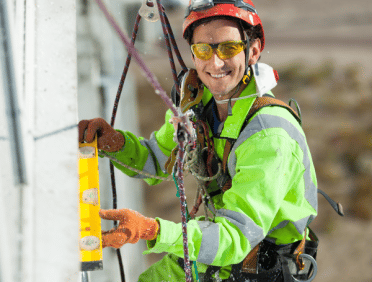The importance of understanding asbestos myths
It wasn’t so long ago that asbestos was thought of as a harmless material to be used in the construction of buildings all around the world. As times have changed, there has been more and more research into asbestos and its properties.
Since then, it has been discovered that asbestos can be quite a harmful substance when people are exposed to it. Especially for those who work in close contact with it, and for longer periods.
Whilst lots more is known about the hazards of asbestos, it has to be said that there are still some myths and misunderstandings, that surrounded asbestos.
To keep ourselves safe, as well as those around us, it is important to ascertain what is the truth when it comes to asbestos and what is a part of the myth about it.
Let’s take a look at some of the most common ones and where they may come from.
Myth 1: Asbestos is a thing of the past
Asbestos was chosen largely because of its versatility. It could be used in a variety of ways and was relatively cheap to buy and easy to install. It is, as a material, durable and long-lasting and had a high level of fire resistance too.
It grew in popularity throughout the 20th Century and it was found in a variety of places including ceiling tiles, paints, mattresses, heaters and even the felt within pianos.
It was discovered some time ago that asbestos, when inhaled can cause lung diseases, including cancer WHO have stated that they believe that asbestos exposure is the cause of more deaths globally than being exposed to the sun. Here in the UK, asbestos exposure is thought to cause as much as three times as many deaths as road traffic accidents.
Despite this fact, asbestos is often thought to be a thing of the past. The main reason for this is that many of the people who are dying now from asbestos exposure-related issues were exposed to it during the 1980s. This is true, but asbestos is still something that is around and exposure to it can still happen.
This is true not only in commercial properties but also in homes and schools too. We must recognise that we are aware of where asbestos can be found and what it can mean for those who are exposed to it.
Myth 2: Asbestos is harmless if left undisturbed
Another common myth that seems to be around when it comes to asbestos, is that it is completely safe if it is left undisturbed and that it is only when it has been disturbed that it becomes a problem.
There is a reason that this is often thought to be true and for the most part, so long as the asbestos is left alone and is in good condition with no damage or wear and tear; then all is good. However, we all know that a lack of wear and tear is not something that you can keep and over time, things will deteriorate.
Friable asbestos is those asbestos materials that can be easily crushed or crumbled, making a powder. A simple human touch is not enough to cause this to happen, however, if there are regular activities on the material, particularly those that are seen as being abrasive, then this can cause the fibres to break down and then become airborne. It is then when these powders and fibres are inhaled that the problem occurs.
A non-friable asbestos material will not crumble or turn into powder as easily, however, this doesn’t mean that over time it cannot become both of these things. It can happen with regular, everyday wear and tear on products, as well as any accidental damage that can be caused by people or natural occurrences.
Myth 3: Only industrial workers are at risk of asbestos-related diseases
It is often the case that those who are most likely to have some form of asbestos exposure are those who work in industrial roles, this is because they are most likely to come across asbestos in some form in their everyday work.
However, it has to be recognised that they are not the only workers and people who can contract an asbestos-related disease. Some of the main occupations that are at risk of asbestos exposure and the related complications that it can cause include:
Heating engineers
Demolition workers
Carpenters
Plumbers
Roofers
Painters and decorators
Plasterers
Shopfitters
Alarm installers
Computer and data installers
Caretakers
Telecommunication engineers
Electricians
Architects
Cable layers
All of these occupations, can, at some point, be exposed to asbestos in their everyday work.
Myth 4: Asbestos-related diseases are easy to diagnose
This particular myth could not be any further from the truth. Asbestos-related diseases are not easy to diagnose and they can often take a long time to be detectable. For some people, the signs and symptoms that they have been exposed to asbestos may not be noticeable for 20 years, which can make it even harder to diagnose.
The other problem when it comes to the identification of many of these illnesses and diseases is that they can often appear to be just like other diseases out there. Making them even harder to diagnose.
Some of the main symptoms that can occur when you have an asbestos-related disease include:
Chest pain and tightness in breathing
Crackling when inhaling
Coughing that does not go away
Rounded and enlarged fingernails and toenails
Extreme fatigue
Inability to exercise
Weight loss that is not intentional
If you are showing any of these symptoms and signs, then your doctor will want to perform some tests on you to find out more about what is happening.
This may be in the form of a chest x-ray, a CT scan or a lung function test. Once they have performed these tests and identified what the issues is then they can start to plan out a treatment course for you.
Myth 5: Asbestos exposure only occurs in the workplace
Whilst it is true that the majority of asbestos exposure and then in turn asbestos-related illnesses, happen in the workplace, this is not the only way that someone can become exposed to asbestos.
Secondary asbestos exposure has also been identified. This is when those who are working with or around asbestos bring the dangerous fibres home with them after work. These can be transmitted on the clothing of the person or their hair.
These fibres may then transfer to a variety of surfaces in their home, which can then be inhaled by those within the home, therefore, exposing them to asbestos and potentially causing them asbestos-related illnesses.
Myth 6: All types of asbestos are equally dangerous
The term asbestos is more of an overarching term to describe the material. Within this, there are different types of asbestos that you can be exposed to.
In the UK there are three main types of asbestos fibres and whilst they are all toxic, they can have a different risk attached to them.
White asbestos is also known as chrysotile. This is the most commonly used form of asbestos and the contaminant found within it is tremolite. The fibres that are within the chrysotile are usually really fine, and they are flexible. Combined with their heat resistance, they are usually used in brake pads, roofing materials and cement.
Brown asbestos is Amosite, which is particularly strong and heat-resistant. It is most commonly found in cement sheeting, electrical insulation and also plumbing insulation too. This particular type of asbestos has the highest cancer risk when you are exposed to it.
Blue asbestos is crocidolite. This is the type of asbestos that has the finest and thinnest fibres, this means that when they are inhaled, they are most likely to become lodged in your lungs. Along with this, the asbestos material itself is brittle, an incredibly harmful combination. The brittle nature means that it is most likely to break down and these thin fibres are then most likely to be inhaled and lead to asbestos exposure.
Myth 7: Asbestos has been banned, so there’s no need to worry
The use of asbestos was banned in 1999, but that doesn’t mean that there is no need to worry about asbestos and what it may mean for you. Here in the UK, it is now illegal to buy, sell, import or export any materials that contain asbestos. However, there is still plenty of asbestos out there, which means that there is always a cause for concern.
This is a part of the regulations that relate to asbestos and outlines how to properly handle and approach any asbestos materials that you may come across.
For the most part, those who work with asbestos will be fully licensed (and in turn fully trained) which means that they will be as safe as possible from the harmful effects of asbestos and able to protect themselves and those around them.
Myth 8: Asbestos removal is a DIY job
When it comes to dealing with any form of asbestos removal, you are going to want to have the expert advice of a licenced professional. Whilst these do come at a cost, which may not be ideal if you are looking to keep costs down, they are going to be able to properly handle the material and ensure that risks are kept to a minimum.
The main reason for this is that asbestos, even in a small amount, can prove to be incredibly dangerous to you, which means that you need to make sure that you properly handle it. Not only this but certain regulations and legislations are designed to protect people from asbestos and the harmful effects that it can cause. This includes not only the immediate impact on you, as you handle the asbestos. But also on those around you when you are moving it, or you are trying to find a place to dispose of it.
Myth 9: Asbestos exposure only affects older individuals
It is most common to find that those who are older are mostly impacted by the harmful effects of asbestos, rather than those who are younger. There are several reasons for this. The first is that there is a long delay between the exposure to asbestos and the symptoms becoming recognisable and identifiable.
Not only this but there were fewer regulations when working with asbestos a few decades ago, which means that those who were most likely exposed to asbestos are going to be older.
That said, it is important to recognise that asbestos exposure can and does still happen to younger people too. This is particularly true if they are exposed to it frequently and for long periods. Whilst some may have a delay in the onset of their symptoms, it has also been seen that younger people are showing signs of asbestos exposure and are becoming unwell from it.
Myth 10: Asbestos-related diseases are incurable
One of the biggest concerns for those who have an asbestos-related illness is that they are incurable. Whilst they cannot necessarily be cured, they can be treated and you can live as long a life as possible, despite the issues.
The main approach that is taken with asbestos illnesses is to try and manage and minimise the symptoms and ensure that lung function is as preserved and protected as possible. The level of treatment that you need to have will often relate to the severity of the exposure and disease that you have.
Some of the options are:
Oxygen therapy- which is where you receive oxygen through a mask or a tube in your nostrils. This will help you to take in more oxygen and breathe easier.
Pulmonary rehabilitation- these are behavioural and lifestyle changes that are designed to improve your daily lung function, many of what you do will be activity or exercise based.
Lung transplant- if you find that your lung is not going to be able to recover from the exposure, then it may be recommended that you have a lung transplant. These can help to prolong your life and can also help to relieve your day-to-day symptoms and discomfort too.
It may be worthwhile for you finding out a local support group that can help you with your diagnosis and your long-term medical plans. Dealing with any form of illness can be difficult and there is likely to be a variety of feelings and emotions that you will need guiding through.
Importance of asbestos awareness training
To have the best understanding of asbestos and what it can do, it is important to have the right knowledge. This is where Asbestos Awareness Training can help. Covering all the basics that you need to know about asbestos, this training will help to ensure that you are safe and that you can manage asbestos in the right way.
Asbestos Awareness Certificate
If you have asbestos awareness training, then you obtain an Asbestos Awareness Certificate so that you can show that you have had the training and that you understand some of the key information that links to working with asbestos.
You can take an Asbestos Awareness course (£17.50), gain a certificate and ensure your team are compliant by clicking here.
Alternatively, you can access our money saving bundles to save over 50% by taking two or more courses.












